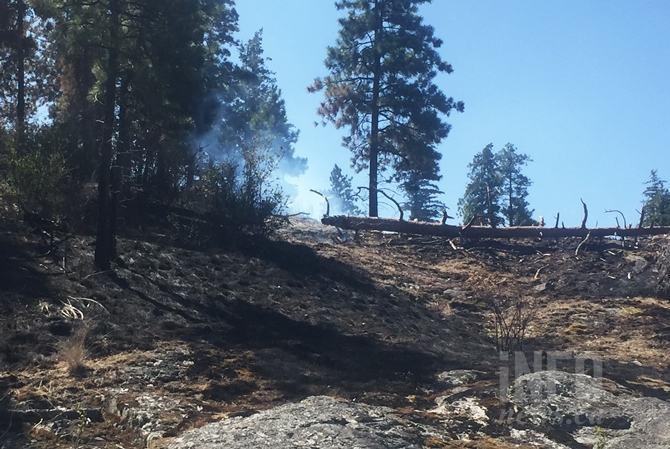
(ADAM PROSKIW / iNFOnews.ca)
July 25, 2018 - 2:29 PM
OPINION
Notes and observations from last week's wildfires in the Okanagan:
***
I spend a lot of time in Okanagan Mountain Park, usually from a kayak watching bald eagles, bears, birds and stunning landscapes. So I have to commend B.C. Wildfire for letting it burn when lightning struck multiple times July 17 touching off several wildfires.
I’m not sure they did it for the right reasons. When fire ignited in more than a dozen locations in the region in a single evening, they tell us they triaged the need and found the fires in the park the lowest risk.
I wish they said they let it burn because of improved policy, but still: I know it was difficult for them. It was one of the most visible fires and made great fodder for all the Armchair Fire Bosses. It clearly created some panic among anyone who was here in 2003. I don't mean to be harsh but we have to get over that.
Incident commander Glen Burgess said, “people are living in the past on that fire" and he’s right.
The problem in 2003 was Okanagan Mountain park hadn’t had any sizeable fire in at least 50 years, according to the Filmon report, but it could have been 50 to 100 years longer than that. I heard Nick Arkle, then the woodlands manager for Gorman Brothers Lumber levy warnings a year before the fire that so much fuel had built up in the park, a fire would be unstoppable.
It certainly was. But not this year.
I was out late last Thursday night photographing both the Mount Eneas fire and the Good Creek fire in the park and you could literally see the difference. Eneas was dark red, glowing against its own smoke as vast swaths of dense forest burned hot like staring at the embers of a fire pit. Okanagan Mountain park was yellow-orange like the top of a match. The difference made by fuel load was remarkable.
I went to the park last Sunday and from what I could see, it was mostly a grassfire in a forest. That’s what happens when fires are allowed to clean up ladder fuels. It’s how coniferous forests are supposed to develop. If we keep putting out fires needlessly, the fuel load builds and we get the 2003 fire that burned 239 homes, and most of the KVR trestles. Letting this fire burn a bit just reset the clock.
It’s tempting, even for, say, a retired city fire chief to suggest we should attack every forest fire immediately — but that’s incredibly short-sighted.
Forests are different than homes and neighbourhoods. With every small fire we put out in the forests, we stave off the inevitable Big One.
Now look around the entire Okanagan. Look at the forests they don’t cut because logging is ugly for tourists. How long have these stands gone without fire?
We have to do something about all that fuel because 2003 was not an anomaly. It was predictable and inevitable. And so is the next one.

Ladder fuels at work. You can see from this July 22 picture that mostly what burned in the park was grass. The smoke you see is a downed log still smouldering. Those are ladder fuels and we need fires to reduce those so small fires don't elevate into uncontrollable crown fires.
(MARSHALL JONES / iNFOnews.ca)
***
For a more complete rationale on why we need to let some forests burn, particularly in parks, and for explanation of why firefighting is at least partially responsible for the out of control fires we saw then and since, the Filmon Report of 2004 goes into great detail.
On page 5, the authors note they “reached many of the same conclusions as previous studies.”
Or you can read George Abbott’s report published in April this year about last year’s wildfire and disaster management.
On page 12, the authors say: ‘We recognize that some recommendations we are making may have been previously made elsewhere.”
There's nothing new in these analyses. We have known this stuff for decades. What would be new is if the B.C. government actually did what it spent millions of dollars on these reports telling them what to do.
They must be held accountable for their inaction.
***
Everyone understands that hellscape forest fire photos taken at night rarely reflect what we actually see with our eyes, right? Everyone knows the exposures are long by necessity and unfortunately tend to embellish, right? Ok, good.
***
Good on y’all for helping tourism in the Okanagan as they try to bring some sanity and clarity to wildfire coverage for everyone outside of the region.
But how about the rest of us inside the region?
All these headlines appeared on the same popular news website and chances are you read it and shared it.
-
South Okanagan on fire
-
Interior on fire
-
Leave home now
-
Fireballs drop from sky
-
Building a superfire
Is that really what you experienced last week? You good with this?
***
I'd like to say a personal thanks to everyone who did not go on about the Martin Mars bomber.
***
B.C. and the Okanagan learned a lot of lessons in 2003. Here's another.
Before Okanagan Mountain Park, huge fires in Barriere and McClure were the ongoing concern and communication there was a disaster.
Residents were all but cut off from information about what was happening. A report on lessons learned from that fire lists communications at the top but surely understates the problem: “There was no main source of communication for officials, community members and the media to obtain information about the fire.”
I recall stories of citizens and reporters fighting with fire officials and jumping lines to fill the void of information, creating more issues and chaos.
Kelowna was entirely different. Emergency officials communicated with everyone and divulged everything. They gave regular and nearly instant updates. They didn’t fart around with tourist concerns, they didn't bury the ledes under happy-smily messages about enjoying the lake or evade questions or withhold information or leave a single phone call unreturned. They met with people face to face. They supervised access to burned areas for residents and the news media. They gave information simply and plainly.
That gave them immense credibility and people trusted them and listened to them and followed directions without question.
Then-Fire Chief Gerry Zimmermann was right when he said that was why they had calm and not panic when they evacuated one-third of the city.
Can everyone involved in emergency operations please remember those lessons?
I’ve noticed some bizarre changes over the past year at both Central Okanagan Emergency Operations and B.C. Wildfire I hope to explore more in depth later but despite my quibbles, they remain the gold standard in communicating in emergencies.
They shine even brighter when you see emergencies in other jurisdictions. I'm looking at you, Summerland, Kamloops and T’kemlups — you need to be better at this.
— Marshall Jones is the editor of iNFOnews.ca
News from © iNFOnews, 2018